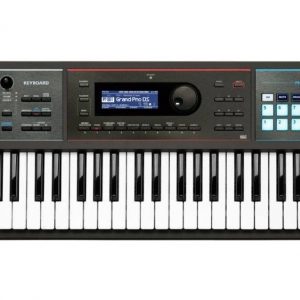Korg ARP Odyssey
$477.99
Experience the power of a classic synthesizer with the Korg ARP Odyssey – an iconic analog synthesizer with a vast array of controls and features for creating unique sounds.
Compare
Description
The Korg ARP Odyssey is a modern reincarnation of the classic analog synthesizer, the ARP Odyssey, which was first introduced in 1972. This synth was one of the pioneering analog synthesizers in the world of music, and many musicians and producers of the time used it extensively to create some iconic sounds that are still highly regarded today. Now, Korg has modernized the Odyssey with new features and a sleeker design, making it easier than ever to create rich, warm, and complex analog sounds.
One of the most striking features of the Korg ARP Odyssey synthesizer is its compact size. Unlike many other analog synths that are bulky and heavy, the Odyssey is portable and easy to take on-the-go. It measures just 495mm x 380mm x 125mm and weighs 4.1kg, making it ideal for musicians who want to make music on the move. It’s also perfect for smaller studios or home setups where space is limited.
The Korg ARP Odyssey is highly intuitive and easy to use. It features two VCOs (Voltage-Controlled Oscillators) with sawtooth, square, and pulse waveforms, as well as a noise generator. There are also two envelope generators, a low-pass filter, a high-pass filter, and an LFO (Low-Frequency Oscillator) that can be used to modulate different aspects of the sound. The synth is monophonic, which means it can only play one note at a time, but this is perfect for creating basslines or lead melodies.
One of the standout features of the Korg ARP Odyssey synthesizer is its ability to reproduce the classic sounds of the original ARP Odyssey, which was used by some of the biggest names in music of the 70s and 80s, including Herbie Hancock, Van Halen, and Gary Numan. The modern version of the synth includes all three filter types from the original Odyssey, as well as all of the CV/Gate jacks that were so important for controlling other analog gear at the time. Whether you’re a fan of old-school analog sounds or want to create something entirely new, the Korg ARP Odyssey is the perfect tool for the job.
In terms of connectivity, the Korg ARP Odyssey synthesizer has MIDI in/out/thru and USB MIDI support, which means it’s easy to integrate with other digital gear. It also has headphone and stereo output jacks, as well as a dedicated external input, which makes it easy to process external sounds through the synth’s filters and other effects.
Overall, the Korg ARP Odyssey synthesizer is a versatile and powerful analog synth that combines the best of modern technology with the classic sounds of the past. Its compact size, intuitive controls, and powerful sound engine make it a great choice for musicians and producers of all levels, whether you’re just starting out or have been making music for years.
Korg ARP Odyssey properties
| Product name |
Korg ARP Odyssey |
| Brand |
Korg |
| Type |
Synthesizers |
| Drawbars/Sliders |
Yes |
| Pads |
Yes |
| Rotary Controls |
Yes |
| Colour |
Black, Orange |
Frequently Asked Questions:
What unique features does the Korg ARP Odyssey synthesizer possess that differentiate it from other analog synthesizers on the market?
The Korg ARP Odyssey synthesizer stands out among other analog synthesizers due to several unique features. Firstly, it is a faithful reproduction of the classic ARP Odyssey synthesizer, originally designed by Alan Roach and David Pastel in the early 1970s. This ensures that the new Korg version retains the distinctive sound and character of the original. Secondly, the Korg ARP Odyssey incorporates some significant updates and improvements over its predecessor. For example, it features fully restored circuitry, updated components for greater stability, and modern enhancements such as MIDI connectivity and USB support. This makes it easier to integrate into a contemporary setup and simplifies the process of using it with other digital devices. Thirdly, the Korg ARP Odyssey is available in both desktop and semi-modular formats, providing users with greater flexibility in terms of how they use and configure their synthesizer. The semi-modular version allows for greater customization by enabling users to connect various modules together using patch cables. Lastly, the Korg ARP Odyssey is highly regarded for its unique and versatile sound. Its dual oscillator configuration enables users to create complex and rich harmonies, while the filter section offers a wide range of tonal possibilities. Additionally, the envelopes are particularly powerful and responsive, which can be used to shape sounds in intricate ways. Overall, the Korg ARP Odyssey's combination of classic heritage, modern updates, versatile sound capabilities, and flexible configuration options make it a standout choice among analog synthesizers on the market.
How can I correctly program and utilize the dual filter system on the Korg ARP Odyssey synthesizer to achieve unique and complex sounds?
To use the dual filter system on the Korg ARP Odyssey synthesizer for creating unique and complex sounds, follow these steps:
1. Connect both filters by pressing the "Dual" button located near the filter section. This will activate the second filter and allow you to manipulate it independently. Adjust the cutoff frequency of each filter using the corresponding knobs. You can use a wide range of frequencies, from low-pass to high-pass or band-pass filters, to create different tonal characteristics. Apply envelope generators (EGs) to both filters for added modulation. The EG1 is assigned to filter 1 by default, but you can switch it to filter 2 by pressing the "EG" button and selecting the desired destination using the "F1" or "F2" switches. Use the "Resonance" knob to increase the self-oscillation of each filter, creating a more pronounced resonant sound. This can be especially effective when both filters are set to high frequencies. Experiment with different routing options by selecting the source of each filter using the "Source" switch. For example, you could route an external audio source into one of the filters for added texture and complexity. Use the "Mix" knob to blend the filtered signal from both filters together, allowing you to achieve a wide range of sonic textures from subtle modulation to extreme resonance. Finally, consider adding additional effects such as delay, reverb or distortion to further shape and manipulate the sound. Remember to always start with small adjustments and listen carefully to the results before making more drastic changes.
How does the dual filter circuit of the Korg ARP Odyssey differ from traditional analog synthesizers, and what unique sonic possibilities does it offer?
The dual filter circuit in the Korg ARP Odyssey is a standout feature that sets it apart from traditional analog synthesizers. While most synthesizers have a single filter, the Odyssey has two independent filters that can be used simultaneously or separately to create complex and intricate sounds. This allows for greater flexibility and versatility in shaping the frequency response of the sound, enabling a wider range of tonal possibilities. The dual filter circuit also provides unique sonic possibilities such as resonant self-oscillation, ring modulation between the filters, and parallel and series filtering arrangements. Overall, this innovative design element offers a greater degree of sonic exploration and creative freedom for musicians and sound designers alike.
How does the Korg ARP Odyssey's self-oscillating filter differ from traditional filters, and what unique tonal characteristics does this create?
The Korg ARP Odyssey's self-oscillating filter differs from traditional filters in that it can oscillate at a frequency independent of the input signal. This allows for unique tonal characteristics such as complex harmonics and resonant sweeps, giving the filter a distinctive "wow" sound that is particularly pronounced when playing melodic lines with fast filter cuts. Additionally, because the filter oscillates at a fixed frequency, it can be used to create stable drones or pulsating textures without needing an external oscillator. Overall, this self-oscillating filter adds versatility and sonic interest to the Odyssey's already impressive synthesis capabilities.
What are the key differences between the original ARP Odyssey and its re-releases, such as the 2015 Korg reissue, in terms of circuitry, components, and sound quality?
1. Circuitry:
- The original Odyssey had a complex circuit design with multiple layers of ICs (Integrated Circuits). The re-releases simplified this circuitry by using modern microcontrollers and digital-to-analog converters (DACs) for the voltage control. Components:
- The re-issues use modern components, such as surface-mount devices, which offer improved performance and reliability compared to the through-hole components used in the original Odyssey. Additionally, the re-issues often include features like a reset button, a more convenient interface, and sometimes even additional functionalities or options for customization. Sound Quality:
- The sound quality of both the original and the modern re-releases is essentially identical, as they share the same circuit topology (albeit with some simplifications). However, due to the use of modern components and a more stable power supply, the re-issues tend to be more reliable and consistent in their performance. It's worth noting that while the re-issues offer improved convenience, durability, and reliability compared to the original Odyssey, they lack the charm and uniqueness associated with the original instrument. The original Odyssey was known for its quirks and character, which many users cherished.
Before you buy Korg ARP Odyssey








Reviews
There are no reviews yet.